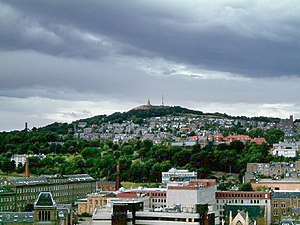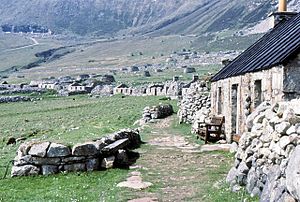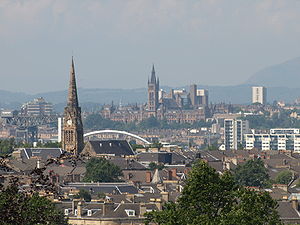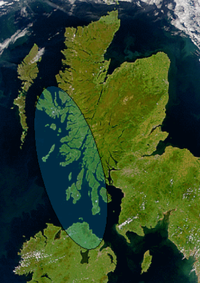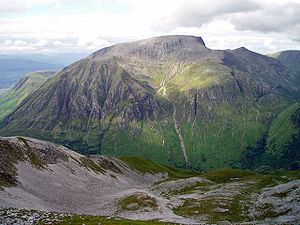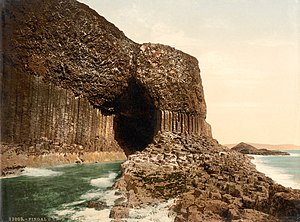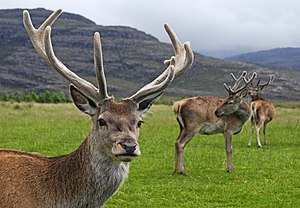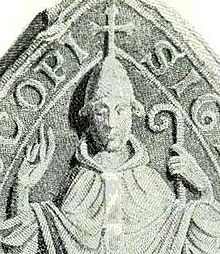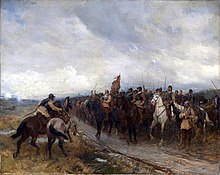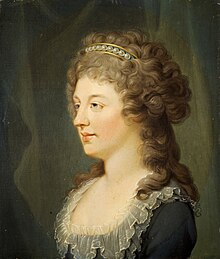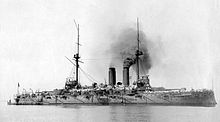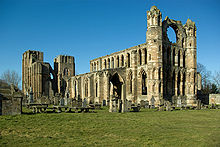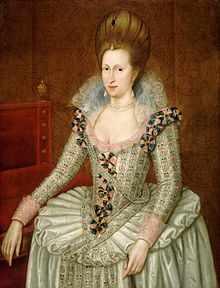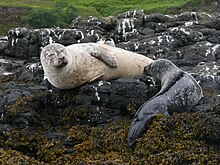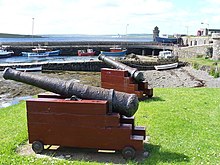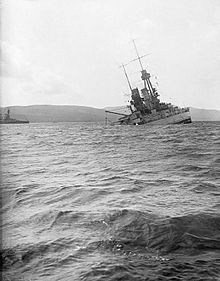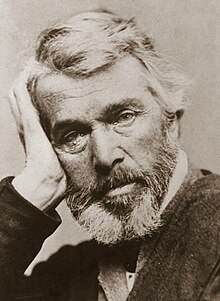User:Cactus.man/Sandbox/P-Sco/Selected articles
The Scotland Portal
| Main Page | Selected articles | Selected biographies | Selected quotes | Selected pictures | Featured Content | Categories & Topics |
Hand picked articles 1
Hand picked articles 2
Featured articles
Featured articles

The West Highland White Terrier, commonly known as the Westie, is a breed of dog from Scotland with a distinctive white harsh coat with a somewhat soft white undercoat. It is a medium-sized terrier, although with longer legs than other Scottish breeds of terrier. It has a white double coat of fur which fills out the dog's face, giving it a rounded appearance.
The breed is intelligent, quick to learn, and can be good with children, but does not always tolerate rough handling. The Westie is an active breed, and is social with a high prey drive, as they were once used to hunt rodents. (Full article...)
Romanticism in Scotland was an artistic, literary and intellectual movement that developed between the late eighteenth and the early nineteenth centuries. It was part of the wider European Romantic movement, which was partly a reaction against the Age of Enlightenment, emphasising individual, national and emotional responses, moving beyond Renaissance and Classicist models, particularly into nostalgia for the Middle Ages. The concept of a separate national Scottish Romanticism was first articulated by the critics Ian Duncan and Murray Pittock in the Scottish Romanticism in World Literatures Conference held at UC Berkeley in 2006 and in the latter's Scottish and Irish Romanticism (2008), which argued for a national Romanticism based on the concepts of a distinct national public sphere and differentiated inflection of literary genres; the use of Scots language; the creation of a heroic national history through an Ossianic or Scottian 'taxonomy of glory' and the performance of a distinct national self in diaspora.
In the arts, Romanticism manifested itself in literature and drama in the adoption of the mythical bard Ossian, the exploration of national poetry in the work of Robert Burns and in the historical novels of Walter Scott. Scott also had a major impact on the development of a national Scottish drama. Art was heavily influenced by Ossian and a new view of the Highlands as the location of a wild and dramatic landscape. Scott profoundly affected architecture through his re-building of Abbotsford House in the early nineteenth century, which set off the boom in the Scots Baronial revival. In music, Burns was part of an attempt to produce a canon of Scottish song, which resulted in a cross fertilisation of Scottish and continental classical music, with romantic music becoming dominant in Scotland into the twentieth century. (Full article...)
In the arts, Romanticism manifested itself in literature and drama in the adoption of the mythical bard Ossian, the exploration of national poetry in the work of Robert Burns and in the historical novels of Walter Scott. Scott also had a major impact on the development of a national Scottish drama. Art was heavily influenced by Ossian and a new view of the Highlands as the location of a wild and dramatic landscape. Scott profoundly affected architecture through his re-building of Abbotsford House in the early nineteenth century, which set off the boom in the Scots Baronial revival. In music, Burns was part of an attempt to produce a canon of Scottish song, which resulted in a cross fertilisation of Scottish and continental classical music, with romantic music becoming dominant in Scotland into the twentieth century. (Full article...)
Dowhill Castle is a ruined castle in Perth and Kinross, Scotland. Sited on a hill near Loch Leven, the oldest part of the castle was built in around 1500 as a tower house. The main structure was extended in around 1600 with additional living space, as well as a tower and turret. The castle had a fortified courtyard (barmkin) to the north with a separate tower. There were probably four storeys but only two still survive.
The site was owned for many years by the Crambeth family before it passed to the Lindsay family, who built the castle, at the end of the fourteenth century. A series of legal decisions impoverished the Lindsays and they were forced to sell their estate and castle to William Adam in the mid eighteenth century. Though still fit for use as a gentleman's residence, Adam used the castle to house labourers. The structure decayed into ruin and was given by Adam to his son Robert Adam. The latter Adam, an architect, is thought to have been inspired by the castle in his designs for Seton, Dalquharran, and Culzean castles. The stonework at Dowhill was quarried in the nineteenth century until only the ground floor and part of the first floor remained. The castle received protection as an ancient monument in 1936 and a listed building in 1971. (Full article...)
Forth Valley Royal Hospital is a hospital located in Larbert, Scotland. With 860 inpatient beds, 25 wards, and 16 operating theatres, it was Scotland's largest ever NHS construction project at the time but has been surpassed by the New Southern General hospital amongst others. Built at a cost of £300 million on the site of the old Royal Scottish National Hospital, it opened to its first patients in 2010. It is operated by NHS Forth Valley.
The hospital is the first in Scotland to have a Forestry Commission ranger on site, whose job is to encourage the use of the 70-acre (28 ha) grounds formerly belonging to the Larbert House estate. It has Scotland's first fully robotic pharmacy, in which robots dispense and label medicines. The hospital also employs robots to carry out tasks such as removing waste, delivering food to wards, and cleaning operating theatres. (Full article...)
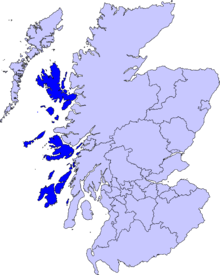
The Inner Hebrides (/ˈhɛbrɪdiːz/ HEB-rid-eez; Scottish Gaelic: na h-Eileanan a-staigh, lit. 'the Inner Isles') is an archipelago off the west coast of mainland Scotland, to the south east of the Outer Hebrides. Together these two island chains form the Hebrides, which experience a mild oceanic climate. The Inner Hebrides comprise 35 inhabited islands as well as 44 uninhabited islands with an area greater than 30 hectares (74 acres). Skye, Mull, and Islay are the three largest, and also have the highest populations. The main commercial activities are tourism, crofting, fishing and whisky distilling. In modern times the Inner Hebrides have formed part of two separate local government jurisdictions, one to the north and the other to the south. Together, the islands have an area of about 4,130 km2 (1,594 sq mi), and had a population of 18,948 in 2011. The population density is therefore about 4.6 inhabitants per square kilometre (12 inhabitants per square mile).
There are various important prehistoric structures, many of which pre-date the first written references to the islands by Roman and Greek authors. In the historic period the earliest known settlers were Picts to the north and Gaels in the southern kingdom of Dál Riada prior to the islands becoming part of the Suðreyjar kingdom of the Norse, who ruled for over 400 years until sovereignty was transferred to Scotland by the Treaty of Perth in 1266. Control of the islands was then held by various clan chiefs, principally the MacLeans, MacLeods and MacDonalds. The Highland Clearances of the 19th century had a devastating effect on many communities and it is only in recent years that population levels have ceased to decline. (Full article...)
The 1966 European Cup Winners' Cup final was an association football match between Borussia Dortmund of West Germany and Liverpool of England played on 5 May 1966 at Hampden Park, Glasgow, Scotland. It was the final match of the 1965–66 season of Europe's secondary cup competition, the European Cup Winners' Cup. Both sides were competing in their first European final.
Each club needed to progress through four rounds to reach the final. The rounds were contested over two legs, with a match at each team's home ground. Borussia's ties varied from close affairs to comfortable victories. They beat Atlético Madrid by a single goal over two legs, while they defeated Floriana 13–1 on aggregate in the first round. Liverpool's ties were mainly close affairs. Only one of Liverpool's ties was won by more than two goals. (Full article...)
Each club needed to progress through four rounds to reach the final. The rounds were contested over two legs, with a match at each team's home ground. Borussia's ties varied from close affairs to comfortable victories. They beat Atlético Madrid by a single goal over two legs, while they defeated Floriana 13–1 on aggregate in the first round. Liverpool's ties were mainly close affairs. Only one of Liverpool's ties was won by more than two goals. (Full article...)
Krysty Norma Lesley Wilson-Cairns (born 26 May 1987) is a Scottish screenwriter. Born and raised in Glasgow, she studied at the Royal Conservatoire of Scotland and the National Film and Television School. During her teenage years, she was a runner on television series including the detective show Taggart. Her script for the unproduced science fiction thriller Aether made the 2014 Black List and led to a staff writer role on the television show Penny Dreadful. Her feature film debut was the screenplay for the Sam Mendes-directed 2019 war film 1917. She co-wrote it with Mendes and received nominations for the Academy Award for Best Original Screenplay and the Writers Guild of America Award for Best Original Screenplay. (Full article...)
The Renaissance in Scotland was a cultural, intellectual and artistic movement in Scotland, from the late fifteenth century to the beginning of the seventeenth century. It is associated with the pan-European Renaissance that is usually regarded as beginning in Italy in the late fourteenth century and reaching northern Europe as a Northern Renaissance in the fifteenth century. It involved an attempt to revive the principles of the classical era, including humanism, a spirit of scholarly enquiry, scepticism, and concepts of balance and proportion. Since the twentieth century, the uniqueness and unity of the Renaissance has been challenged by historians, but significant changes in Scotland can be seen to have taken place in education, intellectual life, literature, art, architecture, music, science and politics.
The court was central to the patronage and dissemination of Renaissance works and ideas. It was also central to the staging of lavish display that portrayed the political and religious role of the monarchy. The Renaissance led to the adoption of ideas of imperial monarchy, encouraging the Scottish crown to join the new monarchies by asserting imperial jurisdiction and distinction. The growing emphasis on education in the Middle Ages became part of a humanist and then Protestant programme to extend and reform learning. It resulted in the expansion of the school system and the foundation of six university colleges by the end of the sixteenth century. Relatively large numbers of Scottish scholars studied on the continent or in England and some, such as Hector Boece, John Mair, Andrew Melville and George Buchanan, returned to Scotland to play a major part in developing Scottish intellectual life. Vernacular works in Scots began to emerge in the fifteenth century, while Latin remained a major literary language. With the patronage of James V and James VI, writers included William Stewart, John Bellenden, David Lyndsay, William Fowler and Alexander Montgomerie. (Full article...)
The court was central to the patronage and dissemination of Renaissance works and ideas. It was also central to the staging of lavish display that portrayed the political and religious role of the monarchy. The Renaissance led to the adoption of ideas of imperial monarchy, encouraging the Scottish crown to join the new monarchies by asserting imperial jurisdiction and distinction. The growing emphasis on education in the Middle Ages became part of a humanist and then Protestant programme to extend and reform learning. It resulted in the expansion of the school system and the foundation of six university colleges by the end of the sixteenth century. Relatively large numbers of Scottish scholars studied on the continent or in England and some, such as Hector Boece, John Mair, Andrew Melville and George Buchanan, returned to Scotland to play a major part in developing Scottish intellectual life. Vernacular works in Scots began to emerge in the fifteenth century, while Latin remained a major literary language. With the patronage of James V and James VI, writers included William Stewart, John Bellenden, David Lyndsay, William Fowler and Alexander Montgomerie. (Full article...)
Thomas Carlyle (4 December 1795 – 5 February 1881) was a Scottish essayist, historian, and philosopher from the Scottish Lowlands. A leading writer of the Victorian era, he exerted a profound influence on 19th-century art, literature, and philosophy.
Born in Ecclefechan, Dumfriesshire, Scotland, Carlyle attended the University of Edinburgh where he excelled in mathematics, inventing the Carlyle circle. After finishing the arts course, he prepared to become a minister in the Burgher Church while working as a schoolmaster. He quit these and several other endeavours before settling on literature, writing for the Edinburgh Encyclopædia and working as a translator. He found initial success as a disseminator of German literature, then little-known to English readers, through his translations, his Life of Friedrich Schiller (1825), and his review essays for various journals. His first major work was a novel entitled Sartor Resartus (1833–34). After relocating to London, he became famous with his French Revolution (1837), which prompted the collection and reissue of his essays as Miscellanies. Each of his subsequent works, including On Heroes (1841), Past and Present (1843), Cromwell's Letters (1845), Latter-Day Pamphlets (1850), and History of Frederick the Great (1858–65), were highly regarded throughout Europe and North America. He founded the London Library, contributed significantly to the creation of the National Portrait Galleries in London and Scotland, was elected Lord Rector of Edinburgh University in 1865, and received the Pour le Mérite in 1874, among other honours. (Full article...)
Alexander Patrick Greysteil Hore-Ruthven, 2nd Earl of Gowrie, PC, FRSL (26 November 1939 – 24 September 2021), usually known as Grey Gowrie or Lord Gowrie, was an Irish-born British hereditary peer, politician, and businessman. Lord Gowrie was also the hereditary Clan Chief of Clan Ruthven in Scotland. He was educated at Eton and Oxford, and held posts in academia for a period, in the US and London, including time working with poet Robert Lowell and at Harvard University.
Gowrie was a Conservative Party politician for some years, including a period in the British Cabinet. He held ministerial posts under Margaret Thatcher, in the areas of employment and Northern Ireland, and was Minister of State for the Arts, as well as Chancellor of the Duchy of Lancaster, with responsibility for Civil Service reform. Offered a promotion to full Secretary of State, with responsibility for education across the UK, he turned it down. Previously an arts dealer, he moved to Sotheby's for a reputed salary of around £150,000, chairing parts of the art auction business. He later chaired the Arts Council of England (1994–1998). (Full article...)
Gowrie was a Conservative Party politician for some years, including a period in the British Cabinet. He held ministerial posts under Margaret Thatcher, in the areas of employment and Northern Ireland, and was Minister of State for the Arts, as well as Chancellor of the Duchy of Lancaster, with responsibility for Civil Service reform. Offered a promotion to full Secretary of State, with responsibility for education across the UK, he turned it down. Previously an arts dealer, he moved to Sotheby's for a reputed salary of around £150,000, chairing parts of the art auction business. He later chaired the Arts Council of England (1994–1998). (Full article...)
The A82 is a major road in Scotland that runs from Glasgow to Inverness via Fort William. It is one of the principal north-south routes in Scotland and is mostly a trunk road managed by Transport Scotland, who view it as an important link from the Central Belt to the Scottish Highlands and beyond. The road passes close to numerous landmarks, including Loch Lomond, Rannoch Moor, Glen Coe, the Ballachulish Bridge, Ben Nevis, the Commando Memorial, Loch Ness, and Urquhart Castle. Along with the A9 and the A90 it is one of the three major north–south trunk roads connecting the Central Belt to the North.
The route is derived in several places from the military roads constructed through the Highlands by General George Wade and Major William Caulfeild in the 18th century, along with later roads constructed by Thomas Telford in the 19th. The modern route is based on that designed by Telford, but with a number of improvements primarily dating from the 1920s and 30s. These include a diversion across Rannoch Moor, and another around Loch Leven which was subsequently replaced by the Ballachulish Bridge. (Full article...)
The route is derived in several places from the military roads constructed through the Highlands by General George Wade and Major William Caulfeild in the 18th century, along with later roads constructed by Thomas Telford in the 19th. The modern route is based on that designed by Telford, but with a number of improvements primarily dating from the 1920s and 30s. These include a diversion across Rannoch Moor, and another around Loch Leven which was subsequently replaced by the Ballachulish Bridge. (Full article...)
Inchdrewer Castle is a 16th-century tower house in the parish of Banff, Aberdeenshire, in the north-east of Scotland. Situated on a slight rise 3.5 miles (5.6 km) south-west of Banff, it looks across to Banff Bay. Originally owned by the Currour family, it was purchased by the Ogilvies of Dunlugas in 1557 and became their main family seat. The Ogilvies were staunch Royalists, which resulted in the castle coming under attack from the Covenanters in 1640. George Ogilvy, 3rd Lord Banff was murdered in 1713 and his body hidden inside the castle, which was then set on fire. The castle came under siege again in 1746, during the Jacobite rising of 1745–46. At the start of the 19th century, following the death of the 8th Lord Banff, the property was inherited by the Abercromby of Birkenbog family, who leased it to a tenant. It became uninhabited after 1836 and the structure deteriorated.
Over the following century the neglect continued until some basic external renovation work was undertaken between 1965 and 1971, making the structure wind and water tight, although it remained unoccupied. The castle was again abandoned and left unmaintained. The condition of the building further declined, becoming derelict. It was in a ruinous state when marketed for sale in April 2013 after the death of Count Robin Mirrlees, who had owned it for about fifty years. At the end of that year it was purchased by the former model Olga Roh, who said she intended to restore it. Modern day reports suggest that the spirit of the 3rd Lord Banff and that of a white dog haunt the castle, which is classified as a category A listed building. (Full article...)

The architecture of Scotland in the prehistoric era includes all human building within the modern borders of Scotland, before the arrival of the Romans in Britain in the first century BCE. Stone Age settlers began to build in wood in what is now Scotland from at least 8,000 years ago. The first permanent houses of stone were constructed around 6,000 years ago, as at Knap of Howar, Orkney and settlements like Skara Brae. There are also large numbers of chambered tombs and cairns from this era, particularly in the west and north. In the south and east there are earthen barrows, often linked to timber monuments of which only remnants remain. Related structures include bank barrows, cursus monuments, mortuary enclosures and timber halls. From the Bronze Age there are fewer new buildings, but there is evidence of crannogs, roundhouses built on artificial islands and of Clava cairns and the first hillforts. From the Iron Age there is evidence of substantial stone Atlantic roundhouses, which include broch towers, smaller duns. There is also evidence of about 1,000 hillforts in Scotland, most located below the Clyde-Forth line. (Full article...)
HMS Hurst Castle (K416) was one of 44 Castle-class corvettes built for the Royal Navy during World War II. Completed in June 1944, she began escorting convoys in August and was sunk by a German U-boat the following month. (Full article...)
The Jocky Wilson Cup (officially the PartyPoker.com Jocky Wilson Cup for sponsorship) was a professional darts team tournament that took place at the Braehead Arena in Glasgow, Scotland, on 5 December 2009. This one-off tournament, which was named after Jocky Wilson, a two-time world darts champion, was the last of the eight non-ranking Professional Darts Corporation (PDC) events of the 2009 season. The tournament was contested by two nations of two players each. The winning nation was the first country to earn four points over a five-match series – four singles fixtures and one doubles game.
Phil Taylor and James Wade of England won the competition and whitewashed their opponents Gary Anderson and Robert Thornton of Scotland 6–0. Wade won the first game against Anderson 6–4; Taylor beat Thornton 6–0 in the second. Wade and Taylor defeated their opponents in the doubles match 6–2 for the overall victory and won their final two singles matches 6–4 over their Scottish opponents. (Full article...)
Phil Taylor and James Wade of England won the competition and whitewashed their opponents Gary Anderson and Robert Thornton of Scotland 6–0. Wade won the first game against Anderson 6–4; Taylor beat Thornton 6–0 in the second. Wade and Taylor defeated their opponents in the doubles match 6–2 for the overall victory and won their final two singles matches 6–4 over their Scottish opponents. (Full article...)

Maybole Castle is a 16th-century castle located on High Street in Maybole, South Ayrshire, Scotland. Originally built for the Earls of Cassillis, it is an L-shaped construction with Victorian two-storey extensions. It is associated with a legend of John Faa, in which an earl killed Faa and imprisoned his wife, the Countess of Cassilis, in the castle.
The castle became a Category A listed building in 1971. It was added to the Buildings at Risk Register for Scotland in 2009, before receiving funding in the early 21st century for renovations. (Full article...)

![Image 1 The Dundee Law Dundee (/dʌnˈdiː/ ⓘ; Scots: Dundee; Scottish Gaelic: Dùn Dè or Dùn Dèagh, pronounced [t̪un ˈtʲeː]) is the fourth-largest city in Scotland. The mid-year population estimate for 2016 was 148,210, giving Dundee a population density of 2,478/km2 or 6,420/sq mi, the second-highest in Scotland. It lies within the eastern central Lowlands on the north bank of the Firth of Tay, which feeds into the North Sea. Under the name of Dundee City, it forms one of the 32 council areas used for local government in Scotland. Within the boundaries of the historic county of Angus, the city developed into a burgh in the late 12th century and established itself as an important east coast trading port. Rapid expansion was brought on by the Industrial Revolution, particularly in the 19th century when Dundee was the centre of the global jute industry. This, along with its other major industries, gave Dundee its epithet as the city of "jute, jam and journalism". Today, Dundee is promoted as "One City, Many Discoveries" in honour of Dundee's history of scientific activities and of the RRS Discovery, Robert Falcon Scott's Antarctic exploration vessel, which was built in Dundee and is now berthed at Discovery Point. Biomedical and technological industries have arrived since the 1980s, and the city now accounts for 10% of the United Kingdom's digital entertainment industry, including mobile app development and gaming. Dundee has two universities – the University of Dundee and Abertay University. In 2014, Dundee was recognised by the United Nations as the UK's first UNESCO City of Design for its diverse contributions to fields including medical research, comics and video games. (Full article...) Read more ... (Full article...)](http://upload.wikimedia.org/wikipedia/en/d/d2/Blank.png)
